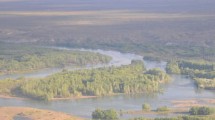Abstract
The population age structure and derived population dynamics (recruitment, growth and mortality), rhizome growth and flowering effort of Cymodocea nodosa in the Ria Formosa (south of Portugal) were examined using reconstruction techniques. The horizontal rhizome elongation rates were low (13.8–30.7 cm year−1), which is consistent with the low population growth rate (−2.35 to 0.29 year−1). The vertical elongation rate was proportional to the horizontal growth except for one stand that was subjected to sand movements and had higher elongation rates. The mean leaf production varied from 11.8 to 14 leaves year−1. The average shoot age varied from 0.70 to 1.04 years, and the oldest shoot found was 7.6 years. The mortality rates were the highest as yet reported for this species (0.99–3.70 year−1). Observed low growth and high mortality are possibly associated with the development of eutrophic conditions in the Ria Formosa. The flowering probability found in Ria Formosa stands (<0.009–0.90 shoots−1 year−1) was comparable to that found in the Mediterranean and off the Canary Islands. Only two stands with flowering events were found inthe Ria Formosa population, which indicates that the stands are highly dependent on clonal growth to maintain themselves inthe Ria Formosa.






Similar content being viewed by others
References
Afonso-Carrillo J, Gil-Rodriguez MC (1980) Cymodocea nodosa (Ucria) Ascherson (Zannichelliaceae) y las praderas submarinas o sebadales en el Archipiélago Canario. Vieraea 8:365–376
Alberto F, Mata L, Santos R (2001) Genetic homogeneity in the seagrass Cymodocea nodosa at its northern Atlantic limit revealed through RAPD. Mar Ecol Prog Ser 221:299–301
Brouns JM (1985) The plastochrone interval method for the study of the productivity of seagrasses; possibilities and limitations. Aquat Bot 21:71–88
Buia MC, Mazzella L (1991) Reproductive phenology of the seagrass Posidonia oceanica (L.) Delile, Cymodocea nodosa (Ucria) Ascherson, and Zostera noltii Hornem. Aquat Bot 40:343–362
Caye G, Meinesz A (1985) Observations of the vegetative development, flowering and seedling of Cymodocea nodosa (Ucria) Ascherson on the Mediterranean coasts of France. Aquat Bot 22:277–289
Cunha AH (1994) Aplicação das técnicas de reconstrução ao estudo da dinâmica populacional de Cymodocea nodosa (Ucria) Ascherson. Masters thesis, University of Algarve, Faro, Portugal
Den Hartog C (1970) The sea-grasses of the world. North Holland, Amsterdam
Duarte CM, San-Jensen K (1990) Seagrass colonization: biomass development and shoot demography in Cymodocea nodosa patches. Mar Ecol Prog Ser 67:297–305
Duarte CM, San-Jensen K (1991) Allometric scaling of seagrass form and productivity. Mar Ecol Prog Ser 77:289–300
Duarte CM, Marbà N, Agawin N, Cebrián J, Enríquez S, Fortes MD, Gallegos ME, Merino M, Olesen B, Sand-Jensen K, Uri J, Vermaat J (1994) Reconstruction of seagrass dynamics: age determinations and associated tools for the seagrass ecologist. Mar Ecol Prog Ser 107:195–209
Ebert TA, Williams SL, Ewanchuk PJ (2002) Mortality estimates from age distributions: critique of a method used to study age distributions. Limnol Oceanogr 47:600–603
Falcão M, Vale C (1990) Study of the Ria Formosa ecosystem: benthic nutrient remineralization and tidal variability of nutrients in the water. Hydrobiologie 207:137–146
Fourqurean JW, Marbà N, Duarte CM (2004) Elucidating seagrass population dynamics: theory, constraints and practice. Limnol Oceanogr (in press)
Gallegos ME, Merino M, Marbá N, Duarte CM (1993) Biomass and dynamics of Thalassia testudinum in the Mexican Caribbean: elucidating rhizome growth. Mar Ecol Prog Ser 95:185–192
Lüning K (1990) Seaweeds. Their environment, biogeography, and ecophysiology. Wiley-Interscience, New York
Mallo S, Vallespinos F, Ferrer S, Vaque D (1993) Microbial activities in estuarine sediments (Ebro Delta, Spain) influenced by organic matter influx. Sci Mar 57:31–40
Marbá N, Duarte CM (1994) Growth response of the seagrass Cymodocea nodosa to experimental burial and erosion. Mar Ecol Prog Ser 107:307–311
Marbá N, Cébrian J, Enríquez S, Duarte CM (1994) Migration of large subaqueous bedforms measured using seagrasses (Cymodocea nodosa) as tracers. Limnol Oceanogr 39:126–133
Martinez-Arroyo A (1990) Estudio ecologico de las algas efemoroficeas: papel en los flujos de material y energia em un sistema estuarico (Bahia de los Alfaques, Delta del Ebro, Espana). PhD thesis, University of Barcelona, Barcelona
Patriquin DG (1973) Estimation of growth rate, production and age of the marine angiosperm Thalassia testudinum Konig. Caribb J Sci 13:111–123
Peduzzi P, Vukovic A (1990) Primary production of Cymodocea nodosa in the Gulf of Trieste (northern Adriatic Sea): a comparison of methods. Mar Ecol Prog Ser 64:197–207
Perez M, Romero J (1992) Photosynthetic response to light and temperature of the seagrass Cymodocea nodosa and the prediction of its seasonality. Aquat Bot 43:51–62
Perez M, Romero J, Duarte CM, Sand-Jensen K (1991) Phosphurus limitation of Cymodocea nodosa growth. Mar Biol 109:129–133
Perez M, Duarte CM, Romero, Sand-Jensen K, Alcoverro T (1994) Growth plasticity in Cymodocea nodosa stands: the importance of nutrient supply. Aquat Bot 47:249–264
Pilkey OH, Monteiro JH, Dias JMA (1989) Algarve barrier islands: a non-coastal plain system in Portugal. J Coast Res 2:239–261
Reyes J (1993) Estudio de las praderas marinas de Cymodocea nodosa (Cymodoceaceae, Magnoliophyta) y su comunidad de epífitos, en El Médano (Tenerife, Islas Canarias). Tesis doctoral, University of La Laguna, Canary Islands
Reyes J, Sansón M, Afonso-Carrillo J (1995) Distribution and reproductive phenology of the seagrass Cymodocea nodosa (Ucria) Ascherson in the Canary Islands. Aquat Bot 50:171–180
Terrados J (1993) Sexual reproduction and seed banks of Cymodocea nodosa (Ucria) Ascherson meadows on the southeast Mediterranean coast of Spain. Aquat Bot 43:293–299
Terrados J, Ros JD (1992) Growth and primary production of Cymodocea nodosa (Ucria) Ascherson in a Mediterranean lagoon: the Mar Menor (SE Spain). Aquat Bot 43:63–74
Acknowledgements
This project was funded by the ICN—Institute for Nature Conservation—Natural Park of Ria Formosa, Portugal. The authors would like to express their gratitude to the park rangers for assistance in the field.
Author information
Authors and Affiliations
Corresponding author
Additional information
Communicated by O. Kinne, Oldendorf/Luhe
Rights and permissions
About this article
Cite this article
Cunha, A.H., Duarte, C.M. Population age structure and rhizome growth of Cymodocea nodosa in the Ria Formosa (southern Portugal). Marine Biology 146, 841–847 (2005). https://doi.org/10.1007/s00227-004-1496-2
Received:
Accepted:
Published:
Issue Date:
DOI: https://doi.org/10.1007/s00227-004-1496-2




